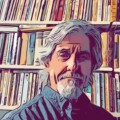An Interview with Artist Brent Kustermann
Brent Kusterman’s paintings and prints have been making their appearance around town this summer. In May you could find some of his work at St. Luke’s Hospital in the new area set aside for artists. In June he was showing at the Red Mug Coffeehouse in Superior. In July you’ll find his work in the Atrium at the Zeitgeist Building in Downtown Duluth. This Friday, July 11, he will be having an opening at the Washington Gallery from 6-9 p.m.
Kusterman considers it to be the duty of an artist to bring a unique perspective to the world, a process “never fully mastered.” He uses a variety of mediums to create his work, sometimes even found objects that others might discard to the trash bin. I found the work worth engaging and if you’re in the neighborhood you may enjoy taking a detour.
EN: Where did you grow up and how did you end up in Duluth?
Brent Kustermann: I have grown up in the Twin Ports area from Superior to all sides of Duluth. My family moved here when I was young from St. Paul. My parents were offered work here and they felt that the Twin Ports would be a good place to raise a family.
EN: How did you come to take interest in art?
BK: It’s hard to pin point the moment when I took an interest in art. I feel that I have always been intrigued by the limitlessness of producing pictures. A portion of that appeal comes from a desire to communicate emotions and ideas with people while also remaining introverted, with respect to deeper questions about the world around us. A bigger appeal is the purity and honesty that comes from laying down colors and designs on a blank canvas or page. I am always interested in what people take away from my work. The freedom of interpretation is amazing. I love it when I have notions about what a piece might mean to me and what other people take away, it is usually completely different. That is the beauty of art; the direct and personal relationship with the viewer and the work. Without that symbiosis the whole thing is pointless.
EN: Where were your trained? Who have been your biggest influences?
BK: I have never really been formally trained. Yes, of course, I’ve taken classes in college and high school but my academic pursuits always formally fell short. I believe that after twenty plus years of producing paintings I have developed a relationship with the work I do that supersedes the rigid constraints of ‘mastering’ (per se) Art under the direction of the university. I have however had encouraging and artistic friends and people in my life that have really helped keep me focused when those tacit moments of insecurity and uncertainty have crept in. Nowadays I usually keep my long-winded diatribes about art on reserve for a really close friend who resides in Chicago. Influentially, I have always loved the allure of the German Expressionists. There is something that defies linguistics that is nostalgic and appreciable. Most certainly, the New York School of Abstract Expressionist are at the backbone of my love for painting. It would probably take a lifetime to get through all of them to fully understand the individuality and depth of each contributing member. And, my interest changes often; one day the intellect of Newman next, the seriousness and loneliness of Rothko.
EN: How do you balance career and creative pursuits?
BK: Making paintings is consumptive emotionally, physically, and spatially. I feel as though, if there were a balance that it happens naturally. I say this because I really don’t force myself to make pieces.
The work I do is a direct manifestation of the energy I feel I must exert artistically much in the same way a runner would feel unbalanced without the endorphin release of a run. At the end of it you feel great. You feel spent. My day job is a completely unrelated matter. I have to eat and I cannot imagine making a living off of art, as nice as that would be, it has never been that way. I am befuddled by the co-mingling of money and art. They are inherently unrelated matters. I don’t even know how to price a piece of work. One dollar may as well be a million.
EN: What do you call your style? And can you explain your process of making pictures?
BK: My style? Well, I suppose would be Non-objective sometimes and Abstract the other times. The process for me is to spend time with the canvas (or whatever material) in the studio. Music has a great way of helping me focus and allow myself to sort of shake off outside noise. By noise I mean, all of those small annoying things that we think about through the day; schedules, bills, appointments, relationships, etc. and how we relate to them. Usually, I start without a plan just an attraction to one color or another and I began to lay out colors and see how they relate to one another and how they draw an emotional charge from me. This can take hours or months, sometimes completely annihilating a composition all together or scavenging aspects of the work that should be saved. There is a great deal of time allowed for drying which affords me the ability to work on several paintings at once when things are going right. There are no limitations as far as materials used. House-paint, professional grade supplies, industrial supplies, dirt, found objects, linen; anything that I find intriguing will suffice.
Sometimes these things, compositional-wise, play out in my favor, other times they end in massive frustration. This is the ongoing process of all things, I suppose.
